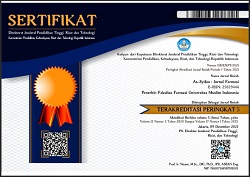EKSPLORASI POTENSI ANTI MALARIA SENYAWA BIOAKTIF Moringa oleifera DENGAN PENDEKATAN IN SILICO
Abstract
Malaria is a global human health problem and also a leading cause of death in tropical and subtropical countries. Over the past fifteen years, the prevalence of malaria has decreased by more than half. However, a new problem emerged, namely the emergence of resistance to existing malaria drugs. Therefore, efforts to develop new malaria drugs are needed to combat the malariad disease. Moringa oleifera is one of the important plants that is widely cultivated in NTT. This plant contains many important pharmacological effects such as anti-asthma, antidiabetic, anti-inflammatory, anticancer, antimicrobial, and others. However, the pharmacological effects of MO plants as antimalarials are not yet clearly known. The aim of this study is to use the in silico approach to investigate the potential of the Moringa oleifera compound which functions as a Plasmodium falciparum dihydrofolate reductase-thymidine synthase (pfDHFR-TS) receptor inhihibitor. The research method used is the in silico approach using TCMSP web based application and molecular docking simulation using USCF Chimera. The results of pharmacological tests and molecular docking simulations show that the bioactive pyhtol compound from Moringa oleifera has potential as a new malaria drug compound. Phytol compound has a MW of 296.6; the number of Hdon and Hacc is 1; OB of 33.82%; TPSA of 20.23 and the number of HL is 2.34. While the energy affinity of pyhtol compounds is -6.4 kcal / mol.
Keywords
Full Text:
Fulltext PDF (Bahasa Indonesia)References
Cowman AF, Healer J, Marapana D, Marsh K. Malaria: Biology and Disease. Cell 2016; 167:610
Cox FE. History of the Discovery Of The Malaria Parasites and Their Vectors. Parasit Vectors 2010; 3:5.
Muheet AS et al. African Journal of Pharmacy and Pharmacology 2013;7:148.
Cortese JF, Plowe CV. Antifolate Resistance Due To New and Known Plasmodium falciparum Dihydrofolate Reductase Mutations Expressed in Yeast. Mol Biochem Parasitol 1998;1;94(2):205-14.
Paikra BK, Dhongade HKJ, Gidwani B. Phytochemistry and Pharmacology of Moringa oleifera Lam. Journal of Pharmacopuncture 2017;20[3]:194-200.
Novian DR, Ikhwani AZN, Winarso A. Uji Farmakodinamik, Drug-Likeness, Farmakokinetik dan Interaksi Senyawa Aktif Kayu Ular (Strychnos lucida) Sebagai Inhibitor Plasmodium falciparum Secara In Silico. Jurnal Veteriner Nusantara 2019;2(1):70-78.
Ru J, Li P, Wang J, Zhou W, Li B, Huang C et al.TCMSP: a database of systems pharmacology for drug discovery from herbal medicines. J.Cheminform 2016;6;1–6.
Volford A. Marvin Sketch. Chem Axon Marvin Sketch. 2015
Vanichtanankul J, Chitnumsub P, Kamchonwongpaisan S, Yuthavong Y. Wild-type Plasmodium falciparum DHFR-TS Complexed With Cycloguanil and NADPH. Antimicrob. Agents Chemother 2012; 56: 3928-35
Aja PM, Nwachukwu N, Ibiam UA, Igwenyi O, Offor CE, Orji UO. Chemical Constituents of Moringa oleifera Leaves and Seeds from Abakaliki, Nigeria. American Journal of Phytomedicine and Clinical Therapeutics 2014;310-321
Hanwell M, Curtis D, Lonie D, et al. Avogadro: An Advanced Semantic Chemical Editor, Visualization, and Analysis Platform. Journal of Cheminformatics 2012;4:8
Ertl P. et al. Fast Calculation Of Molecular Polar Surface Area As A Sumof Fragment-Based Contributions and Its Application To The Prediction Of Drug Transport Properties. J. Med. Che 2000; 43: 3714–3717.
Madden J. C. In silico Approaches For Predicting ADME Properties. In, Recent advances in QSAR studies.Springer 2010; 283–304.
Shen M. et al. Drug-Likeness analysis Of Traditional Chinese Medicines: property Distributions Of Drug-Like Compounds, Non-Drug-Like Compounds and Natural Compounds From Traditional Chinese medicines. J. Cheminformatics 2012; 4: 1–13.
Tao W, et al. Network Pharmacology-Based Prediction Of The Active Ingredients And Potential Targets of Chinese herbal Radix Curcumae Formula For Application To Cardiovascular Disease. J. Ethnopharmacol 2013;145: 1–10.
Veber DF et al. Molecular Properties That Influence The Oral Bioavailability of Drug Candidates. J. Med. Chem 2002;45: 2615–2623.
Xu X, et al. A Novel Chemometric Method for the Prediction of Human Oral Bioavailability. Int. J. Mol. Sci 2012; 13; 6964–6982.
Yao Y, et al. A novel Systems Pharmacology Model For Herbal Medicine Injection: A Case Using Reduning Injection. BMC Complement. Altern. Med. 2014.
O'Boyle, Noel M, Banck, Michael, James, Craig A, et.al. Open Babel: An Open Chemical Toolbox. Journal of Cheminformatics 2011; 3:10.
Pettersen, Eric F, Goddard, Thomas D, et.al. Chimera - A visualization System For Exploratory Research and Analysis. Journal of Computational Chemistry 2004; 25(13):1605-1612.
David TI, Adelakun NS, Omotuyi OI, et al. Molecular Docking Analysis Of Phyto-Constituents From Cannabis Sativa With DHFR. Bioinformation 2018; 14(9): 574-579.
DOI: https://doi.org/10.56711/jifa.v11i2.571
Refbacks
- There are currently no refbacks.
Indexed by:
ISSN: 2085-4714 | e-ISSN: 2502-9444
Editor's Address:
Faculty of Pharmacy, Univeristas Muslim Indonesia
2nd Campus of UMI: Jl. Urip Sumoharjo km. 5 , Makassar, South Sulawesi, Indonesia
E-mail: jurnal.farmasi@umi.ac.id















